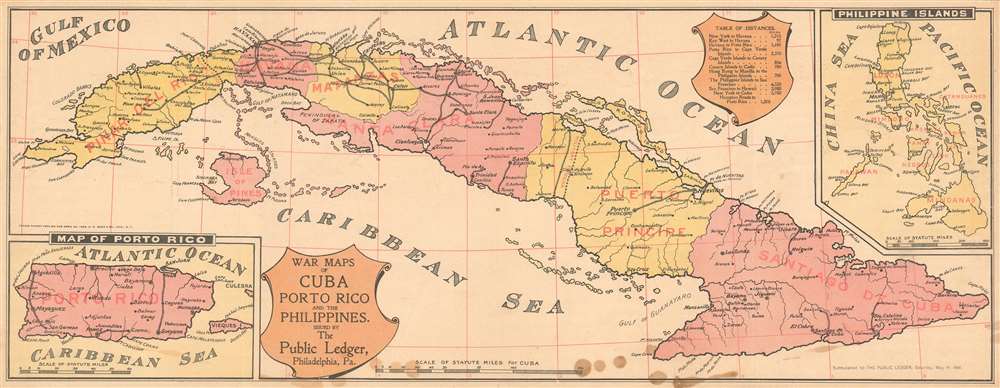1898 Public Ledger Map of Cuba and the Philippines during the Spanish American War
CubaPhilippines-publicledger-1898
Title
1898 (dated) 10 x 25.5 in (25.4 x 64.77 cm) 1 : 2000000
Description
Cuba
Cuba occupies most of the sheet and cities and towns are labeled throughout the island. Several railroads are also illustrated, and provinces are shaded different colors to allow for easy differentiation. The Isle of Pines is identified along with several groups of smaller islands along the coast. A table of distances, providing viewers with some idea of global distances, particularly between major cities in the United States and Cuba and the Philippines, appears on a shield in the upper right.The Philippines
The Philippines are illustrated in an inset situated in the upper right. Many of the archipelago's islands are labeled, including Luzon, Mindoro, Panay, Samar, Leyte, and Mindanao. Cities are also identified, with Manila highlighted in bold block letters. Bays and straits around the archipelago are also labeled.Puerto Rico
A second inset featuring Puerto Rico is situated in the lower left corner next to the title cartouche. Puerto Rico is detailed much the same as Cuba and the Philippines, with cities labeled and the few railroad lines on the island illustrated.The Public Ledger
The Public Ledger was a daily newspaper published from March 25, 1836 until January 1942 in Philadelphia, Pennsylvania. It was founded by William Moseley Swain, Arunah S. Abell, and Azariah H. Simmons and was Philadelphia's first penny paper. At a time when most papers sold for at least five cents, the Public Ledger's founders were hoping to appeal to the broad audience that couldn't afford these more expensive newspapers, which proved to be a fruitful gamble. By 1840 the Ledger had a circulation of 15,000, and a decade later it boasted a circulation of 40,000. For a little perspective, when the Ledger was founded, the entire circulation of newspapers in Philadelphia was estimated to be 8,000. The paper began losing money in the 1860s due to a combination of rising paper and printing costs and lower distribution due to its unpopular support for the Copperhead Policy of opposing the American Civil War and advocating for an immediate peace settlement with the Confederate States of America.George William Childs and Anthony J. Drexel bought the paper in December 1864 and immediately implemented several changes. First, they doubled the price to two cents, raised advertising rates, and changed the paper's position to the Loyalist, pro-Union, line. They also upgraded the quality of the advertising to appeal to higher-class readers. The Ledger next changed hands in 1902 when Adolph Ochs, the owner of The New York Times bought the paper from Drexel's estate. Ochs then sold the paper in 1913 to Cyrus H. K. Curtis, who also owned Ladies' Home Journal and The Saturday Evening Post. Curtis hired his step son-in-law as editor and Curtis and his heirs owned the paper until mounting debts brought on a court-ordered liquidation and the paper ended publication in January 1942.
Publication History and Census
This map was created and printed by G. H. Buek and Company in 1898 and published as a supplement to the Saturday, May 14, 1898 edition of the Public Ledger. The OCLC records two examples which are part of the collections at the Hagley Museum and Library in Wilmington, Delaware, and the Arkansas State Archives in Little Rock, Arkansas.Cartographer
Gustav H. Buek (August 20 1850 – February 8, 1927) was an American lithographer of German descent active in the latter part of the 19th century. Buek was born in Boston, Massachusetts and moved to Brooklyn, New York as an infant, where he lived the rest of his life. He apprenticed with Hatch and Company, Lithographers of New York. After his apprenticeship, in 1866, he took work with Donaldson Brothers, for whom he headed their art department. In 1881, partnering with F. H. Linder, he founded the firm of Buek and Linder with an office at 65 Warren Street, New York. Linder retired in 1884, after which Buek changed the name to G. H. Buek and Company and took on a new partner, Léon Marié. They also moved to more spacious office at 146-150 Center Street. In 1891, G. H. Buek and Company they merged with the American Lithograph Company. He is credited with being the first to introduce facsimile watercolor work to commercial lithography. Buek was a member of New York City's Salmagundi Club. At the time of his death, Buek was also the president of the Alco-Gravure Company, which printed gravure sections for twenty-seven newspapers across the United States. After suffering from poor health for several years, Buek journeyed to New Mexico with his wife and a nurse in the hope that climate would improve his condition. Unfortunately, his condition did not improve and he died in Albuquerque. Buek was also a noted art connoisseur and philanthropist. His 'remarkable collection' included paintings, china, and glassware. Buek married his wife Louise Valentine in 1873 and they were married for fifty-four years. More by this mapmaker...

